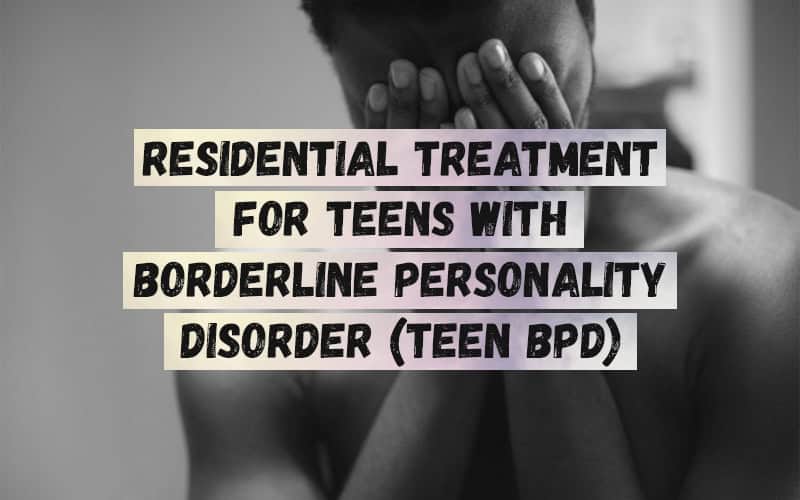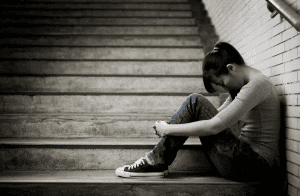Adolescents with borderline personality disorder (BPD) often face intense fear of abandonment, distorted self-perception, and persistent emptiness. They may resort to frantic efforts to avoid abandonment and display self-destructive behaviors. For parents, coping with their teens’ frequent angry outbursts can be draining, leading to strained relationships.
Key Healthcare’s residential treatment for adolescents with BPD can help your child manage their symptoms and build appropriate coping mechanisms. Our structured environment supports teens in regular development by offering stability and predictability. Behavioral and holistic therapies during residential treatment can address underlying issues contributing to BPD, such as childhood trauma, attachment issues, or comorbid mood and anxiety disorders.
This article delves into how residential therapy addresses the difficulties experienced by BPD teens and offers a comprehensive perspective on its effectiveness in supporting their journey toward healing and growth.
Borderline Personality Disorder
Borderline Personality Disorder is a serious personality disorder condition affecting millions worldwide. It is characterized by teen emotional instability, teenage impulsive behaviour, and fragmented self-identity. Individuals suffering from BPD may experience intense mood swings, a persistent sense of emptiness, and indulge in self-destructive behaviors.
Symptoms of BPD in teens
BPD symptoms in teens can be severe, interfering with daily life. Among the most common symptoms of Borderline Personality Disorder in teens are:
- Unstable relationship
- Difficulty controlling emotions
- Substance misuse, binge eating, unsafe driving, or other impulsive behaviors.
- Fear of being abandoned
- Persistent feelings of emptiness
- Suicidal thoughts or self-harming behaviors
- Mood swings that might linger for days or even weeks
Common Causes of Teen Borderline Personality Disorder
The reason for Teen BPD are varied and multifaceted Brain structure, family history, environmental factors, and genetic influences, may all play a role in the development of this disorder.
Brain Structure
Studies have demonstrated that young adults with BPD have smaller frontal lobes, hippocampus, amygdala (although this finding is inconsistent), left orbitofrontal cortex, right anterior cingulate cortex, and right parietal cortex volumes. Additionally, their putamen volume is increased. This affected brain structure frequently creates problems in regulating emotions, impulse control, and decision-making.
Family History
Adolescent BPD appears to run in families, implying the condition may have a hereditary component. According to a journal published, teens with a parent or sibling with BPD are more likely to develop the disorder.
Environmental Factors
Traumatic childhood experiences, such as abuse, neglect, or abandonment, can raise the risk of developing BPD in teens. Other environmental factors, such as prolonged stress, may also affect the disorder’s development.
Genetic Factors
Some research suggests that certain genes may be linked to an increased risk of developing borderline personality disorder in teens. However, more research is required to fully understand the genetic factors contributing to the disorder.
Co-occurring disorders and BPD in Teens.
Co-occurring disorders might make it difficult to diagnose and treat BPD in adolescents. To ensure effective treatment, any co-occurring disorders must be identified and addressed. The common co-occurring mental problems with borderline personality disorder include:
Substances Abuse
Teens with BPD may use drugs or alcohol to cope with their emotions or to avoid feeling empty. Substance usage can exacerbate BPD symptoms and lead to other health complications.
Eating Disorder
Teens with BPD may also suffer from eating problems like anorexia nervosa or bulimia. Eating disorders in teenagers can exacerbate BPD symptoms and lead to serious health problems.
Attention deficit hyperactivity disorder (ADHD)
ADHD is a common co-occurring illness among adolescents suffering from BPD. ADHD in teenagers can aggravate impulsive behavior and emotional dysregulation, making managing BPD symptoms difficult.
Diagnosis of BPD in Teens
Diagnosing BPD in teens is challenging since the symptoms can be confused with ordinary adolescent behavior. If the symptoms persist for a longer period, a mental health expert can evaluate whether the teen has BPD.
Residential Treatment Programs for BPD in Teens
Residential treatment programs provide a safe and supportive setting for teens suffering from BPD. Depending on the individual’s needs, various residential treatment programs are available.
Residential Treatment Centers
Adolescent mental health residential treatment centers offer 24-hour care and assistance to teens with BPD. Individual and teen group therapy, medication management, and life skills training are common components of these programs.
Wilderness Therapy Programs
Wilderness therapy programs provide a novel method for treating BPD in adolescents. Outdoor activities and adventure therapy are part of these programs, which take place in natural surroundings.
Common Treatment Approaches In Residential Treatment for Borderline Personality Disorder
Borderline Personality Disorder (BPD) residential treatment necessitates an integrated approach to deal with the teen personality disorder’s physical and emotional aspects.
Psychotherapy
One of the most effective treatments for BPD is psychotherapy. Teens with BPD can benefit from a variety of methods of treatment, including:
Dialectical Behavior Therapy (DBT)
Teen DBT is a therapy focusing on increasing coping skills, distress tolerance, and interpersonal effectiveness. DBT attempts to assist teenagers with BPD in improving their abilities to regulate their emotions and cope in stressful situations.
Cognitive Behavioral Therapy (CBT)
Another popular type of psychotherapy that can help BPD is Teen CBT program. It helps in detecting and altering undesirable thought patterns and actions. It can also assist teenagers in learning how to manage their emotions and improve their interpersonal interactions.
Schema Therapy (ST)
ST for teens is a type of long-term psychotherapy focusing on understanding and modifying deeply established thinking and behavior patterns. It can be especially beneficial for BPD teenagers with a trauma history. It can also help teens to build a deeper sense of self and strengthen their interpersonal relationships.
Dynamic Deconstructive Psychotherapy (DDP)
Dynamic Deconstructive Psychotherapy is a newer type of psychotherapy focusing on the underlying causes of teen BPD symptoms, such as early childhood events and attachment disorders. Its goal is to assist teenagers in increasing their ability to manage their behavioral symptoms.
Family Therapy
Family therapy for teens with BPD and improve communication and interactions among family members. Family therapy can also assist parents and caregivers in learning how to support and manage their teen with BPD.
Medication
While medication is not usually used as the first-line treatment for BPD, it can help with certain symptoms.
- Mood stabilizers can assist in minimizing impulsive behavior and mood swings in teenagers. They control the amounts of chemicals in the brain that influence mood and behavior.
- Antidepressants can help with teen depression and anxiety, which frequently co-occur with BPD. Antidepressants work by raising the amounts of specific brain chemicals that govern mood.
- Anti-anxiety medications, such as benzodiazepines, can aid in managing severe anxiety and panic episodes. They function by slowing down central nervous system activity and creating a relaxing effect.
Choosing the Right Residential Treatment Program for BPD
Residential treatment programs for Borderline Personality Disorder (BPD) in teens can provide an effective and supportive setting for healing and growth. It is critical to carefully examine and select the best one for your teen’s individual needs.
There are various factors to consider when selecting a residential treatment program for Teen BPD, including :
Staff Credentials and expertise
The treatment center’s staff should have specialized training and expertise working with Teen BPD and experience treating co-occurring illnesses.
Evidence-Based Treatments
Evidence-based treatments for BPD, such as dialectical behavior therapy (DBT), cognitive behavioral therapy for teens, and psychodynamic therapy, should be used in the treatment regimen.
Individualized Treatment Plans
Individualized treatment plans should be developed for each resident based on their specific needs and symptoms.
Family Involvement
The treatment center should involve the family in therapy to ensure long-term success.
Evaluating Programs
There are various aspects to consider while assessing residential treatment facilities for teen BPD. These are some examples.
Treatment Philosophy
The treatment center should have a clearly defined philosophy consistent with evidence-based treatments for Teen BPD.
Treatment Team
The treatment team should comprise trained specialists who have worked with Teen BPD before.
Treatment Duration
The treatment duration should be appropriate as per the severity of the adolescent’s symptoms.
Success Rates
The treatment center should be able to provide data on their Teen BPD success rates and outcomes.
Questions to Consider Before Enrolling
Before enrolling in a residential treatment program for Teen BPD, parents should ask these questions to the authoritative person of the RTC
- What is the resident-to-staff ratio?
- How are evidence-based treatments for teen BPD used?
- How are personalized treatment programs created?
- How involved is the family in the therapeutic process?
Transitioning Back to Home Life-Relapse Prevention
The residential program may have provided a safe and supportive environment for healing and growth; the real work of managing BPD symptoms and maintaining recovery begins when teen participants return to their regular lives. Parents can follow these relapse prevention strategies for a smooth transition to regular life.
Developing a comprehensive aftercare plan
The Key healthcare teen aftercare plan should be tailored to the adolescent’s specific requirements. When developing a comprehensive aftercare plan for an adolescent with BPD, remember the following points:
- Collaborate with the treatment team to develop a personalized aftercare plan that addresses the adolescent’s needs and aspirations.
- Make regular appointments with a mental health professional specializing in treating BPD.
- Consider medication management and, if necessary, consult with a psychiatrist or other medical practitioner.
- Identify possible triggers and stresses and devise a plan to handle them successfully.
Transitioning back to the community
Transitioning back to the community might be difficult for teenagers with BPD. Here are some strategies to consider when returning to regular life after completing a BPD residential treatment program:
- Create an aftercare strategy that includes continuous treatment, medication management, and support services.
- Develop a support system with family and friends to provide emotional and practical assistance.
- Learn and practice coping skills and self-care practices that can aid in managing symptoms and preventing recurrence.
- Communicate with employers, instructors, and other important persons to enable a seamless transition and, if required, to provide accommodations.
Extended Care options
Adolescents with BPD require ongoing counseling to preserve the improvements gained throughout their residential treatment program. Parents can enroll their adolescents in extended care to examine their ideas, feelings, and actions and acquire coping skills and ways to manage their symptoms. Adolescents with BPD who do not get ongoing counseling may relapse and struggle to retain the improvements they gained throughout treatment.
Conclusion
Residential treatment programs provide teenagers with borderline personality disorder with a thorough and rigorous treatment strategy. These programs include a variety of therapies, such as teen individual therapy, group therapy, and family therapy, that are tailored to the adolescent’s specific requirements.
Furthermore, residential treatment programs provide various aftercare options, such as continued therapy and support groups, to assist adolescents in returning to their communities and maintaining their progress. This aftercare is critical for sustaining the benefits established throughout the residential treatment program over time.
Parents, caretakers looking for residential treatment programs for teen BPD can enroll their teen in Keyhealthcare for teen mental health treatment alternatives. Before making any healthcare decisions, conducting extensive research and talking with healthcare specialists is usually advisable.
FAQs – Core
What is Borderline Personality Disorder?
Borderline Personality Disorder is a mental health disease marked by emotional instability, impulsive conduct, acute abandonment anxiety, and unpredictable mood swings.
What are some common symptoms of BPD in teens?
Chronic feelings of emptiness, a distorted sense of self, frantic attempts to prevent abandonment, a propensity for self-destructive activities, frequent outbursts of rage, damaged interpersonal interactions, and splitting and idealization/devaluation are all common signs of BPD in teenagers.
How is BPD diagnosed?
A clinical examination by a mental health expert, including a review of symptoms and medical history, is used to diagnose BPD.
Can BPD be treated?
BPD can be treated with psychotherapy, medication, personality disorder treatment, and other therapies like mindfulness training and group therapy.
What is Teen Residential Treatment?
Teen residential treatment is a rigorous therapy that gives care 24 hours a day, seven days a week, in a regulated setting. It is a highly successful therapeutic option for adolescents suffering from BPD.
How long does Residential Treatment typically last for teens with BPD?
Residential treatment can take anywhere from a few weeks to a few months, depending on the severity of the individual’s ailment.
What are the success rates of Residential Treatment for teens with BPD?
Key healthcare residential treatment for teenagers with BPD has high success rates.
What happens after a teen is discharged from Residential Treatment?
After leaving Residential Treatment, an adolescent may pursue outpatient therapy with the help of family and community support.
Are there any medications that can be prescribed for BPD?
There are no drugs specifically designed to treat BPD; medication may be used to treat co-occurring illnesses like sadness and anxiety.
Can a teen with BPD still attend school while in Residential Treatment?
Yes, teenagers in Residential Treatment can continue to attend school, and many programs offer education and academic help.
FAQs – Longtail
Can teens still visit with their families while in Residential Treatment?
Yes, teenagers in residential treatment can still visit their families.
Will my insurance cover the cost of Residential Treatment for my teen with BPD?
It depends on your insurance coverage. However, many do cover Residential Treatment for adolescents with BPD. Verify your insurance to get more information about your coverage. VERIFY INSURANCE
Can my teen still see their therapist while in Residential Treatment?
It varies on the residential treatment program. However, many enable teens to continue visiting their therapist alongside the program’s therapy.
How do I know if my teen needs Residential Treatment versus outpatient therapy?
A mental health expert can assist an adolescent with BPD in deciding whether residential treatment or outpatient therapy is the best choice.
What recreational activities are offered in Residential Treatment for teens with BPD?
Outdoor activities, athletics, art, music, and other activities may be available in Residential Treatment for teens with BPD.
Are there any alternative therapies offered in Residential Treatment for teens with BPD?
Alternative therapy for adolescents with BPD may include mindfulness techniques, yoga therapy, and meditation.
Can teens with BPD in Residential Treatment have contact with others outside of the program?
It varies on the program. However, many programs prohibit communication with those outside the program to promote a safe and supportive atmosphere.
What happens if my teen’s symptoms worsen while they are in Residential Treatment?
The program staff will analyze the situation and change the treatment plan to address increasing symptoms.
Can Residential Treatment for teens with BPD address substance abuse issues?
Many Residential Treatment programs for adolescents with BPD address substance abuse issues.
How can I best support my teen during their time in Residential Treatment for BPD?
Supporting your teen in Residential Treatment for BPD may entail being involved in their treatment plan, visiting them regularly, and providing emotional support throughout their recovery.
PAA’s
How can Residential Treatment benefit a teen with Borderline Personality Disorder?
Teens with BPD can benefit from residential treatment because it provides an organized and supportive setting where they can acquire coping skills, get tailored therapy, and interact with peers experiencing similar difficulties.
What are some common treatments used in Residential Treatment for teens with BPD?
Dialectical behavior therapy, cognitive-behavioral therapy, and medication management are the common treatments.
How long does Residential Treatment typically last for teens with BPD?
It lasts 30-90 days, depending on the individual’s requirements and development.
Can my teen still attend school while in Residential Treatment for BPD?
Those attending BPD residential treatment can continue their education through on-site schooling or distance learning programs.
How can I find a Residential Treatment program for my teen with BPD?
You can find it by researching, speaking with mental health specialists, and contacting treatment providers directly.
What happens after my teen is discharged from Residential Treatment for BPD?
Teens may continue counseling, medication management, and support from family after leaving residential Treatment for BPD.
What recreational activities are offered in Residential Treatment for teens with BPD?
Teen art therapy, outdoor activities, and group fitness courses are available in residential treatment for teens with BPD.
What is dialectical behavior therapy?
It is a form of treatment for BPD that emphasizes the development of mindfulness, emotional control, and interpersonal skills.
Can adolescent residential treatment centers for depression help with other mental health issues besides BPD?
Yes, Residential Treatment can assist with various mental health concerns, such as depression, anxiety, and PTSD in teens.
How can I support my teen after they complete Residential Treatment for BPD?
You can support your teen with ongoing therapy, medication management, and creating a supportive home environment.





